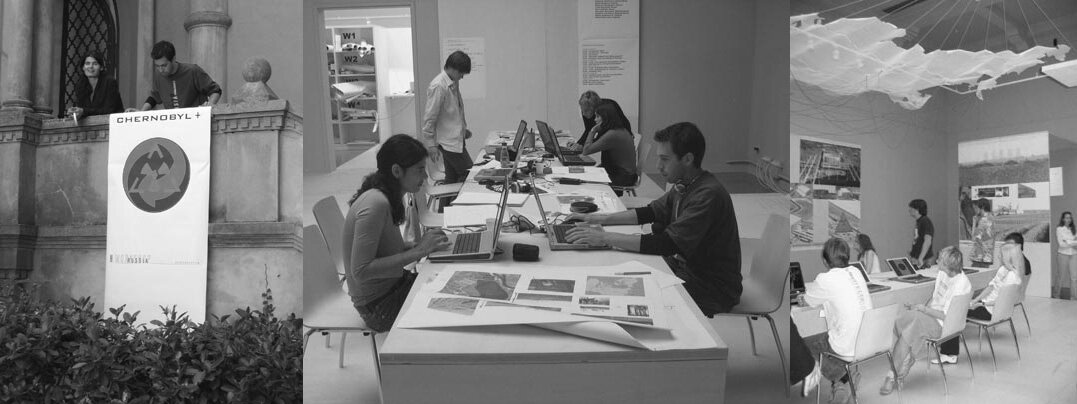teaching
CHERNOBYL+WORKSHOP RUSSIA
Design Workshop
Russian Pavillion Biennale di Venezia 2004
TUTORS
Prof Kjetil Thorsen, Annette Erlenwein
On April 26th, 1986 reactor no.4 of the nuclear plant of Chernobyl, in the Ukraine, exploded.
Since then there has been a restricted area of 30km around the exploded reactor. The 48,000 inhabitants of the city of Pripyat, which is 7km away from the site - mostly workers of the power plant and their families - were evacuated and have not been able to return to their homes ever since. Pripyat is now a ghost town.
The damaged radioactive reactor was enveloped by a concrete sarcophagus, after several weeks of fire fight. Since then it has been repeatedly repaired and finally renewed. The other reactors at the plant were reactivated. In 2000 the nuclear plant of Chernobyl was finally shut down. As a result of the damage 125,000 to 146,000 km² of land has been radioactively contaminated. Two weeks after the catastrophe, winds spread radioactivity throughout Europe. The pollution is long-term, due to the half-life period of the radioactive substances - Iodium 131, Caesium 137, Strontium 90 and Americanum being 8 days, 29, 30 and 433 years, respectively.
In the meantime around 800 citizens of Pripyat - mostly elderly persons - returned to the military restricted area and have been living there illegally since then. About 800,000 people were involved in the fire-fighting and clean-up of the catastrophe. Meanwhile 50,000 of them have died and most of the survivors have become seriously ill. Diseases caused by radioactivity have increased dramatically in Ukraine and the surrounding territories.
The aim of the project is to develop new architectural strategies and tools, through the analysis of the unique situation of Chernobyl. The objective is to develop made-to-measure strategies and general tools, which would be applicable to other situations.
Based on fundamental research on the ecological, political and social consequences of the Chernobyl reactor catastrophe - both worldwide and in the affected areas - urban development scenarios and/or single architectural installations should attempt to provide living conditions for the people on-site. Furthermore, they should provide the necessary infrastructure for scientific research and incentives for commercial investment and industrial settlements.
Am 26 April 1986 explodierte Reaktor 4 des Atomkraftwerks Tschernobyl in der Ukraine.
Um den explodierten Reaktor existiert seitdem eine 30 km breite Sperrzone. Die 48 000 Einwohner der 4 km entfernt liegenden Stadt Pripyat, die meisten davon im Atomkraftwerk beschäftigte Arbeiter und ihre Familien wurden evakuiert und konnten bis heute nicht mehr in ihre Häuser zurückkehren, Prypjat ist eine Geisterstadt.
Der havarierte radioaktiv strahlende Reaktor wurde nach wochenlangen Löscharbeiten mit einem Stahlbetonsarkophag ummantelt. Dieser ist seitdem mehrmals ausgebessert und inzwischen erneuert worden. Die anderen Reaktoren der Anlage wurden wieder in Betrieb genommen, Im Jahr 2000 wurde das Atomkraftwerk Tschernobyl schließlich stillgelegt.
In Folge der Havarie wurden zwischen 125-140 000 km² radioaktiv kontaminiert. Winde verteilten die Radioaktivität in den ersten zwei Wochen nach der Katastrophe über ganz Europa. Die Umweltschädigung ist langfristig, denn die Halbwertszeit der radioaktiven Substanzen Iodium 131, Caesium 137, Strontium 90 und Americium beträgt zwischen 8 Tagen, 29, 30 bzw. 433 Jahren.
Etwa 800 meist ältere Bewohner von Pripyat sind inzwischen in die vom Militär abgeriegelte Sperrzone zurückgekehrt und leben dort illegal. Etwa 800 000 Menschen waren unmittelbar an Lösch- und Aufräumarbeiten der Katastrophe involviert 50 000 von ihnen sind inzwischen gestorben, die meisten der Überlebenden sind schwer erkrankt. In der Ukraine und den angrenzenden Gebieten sind durch Radioaktivität verursachte Krankheiten enorm gestiegen.
Ziel des Projektes ist es in der Auseinandersetzung mit der einzigartige Situation in Tschernobyl neue architektonische Strategien und Werkzeuge zu entwickeln - für die Situation in Tschernobyl -maßgeschneiderte und auch auf andere Situationen übertragbare, universelle.
Auf der Basis grundlegender Recherchen über ökologische, politische und gesellschaftliche Auswirkungen der Reaktorkatastrophe von Tschernobyl, - weltweit und in den betroffenen Gebieten, soll durch städtebauliche Entwicklungsszenarien und einzelne architektonische Initiationsprojekte versucht werden die Lebensbedingungen der Menschen vor Ort zu verbessern, die Infrastruktur für wissenschaftliche Forschung vor Ort zu verankern, und Anreize für wirtschaftliche Investitionen und zur Ansiedlung von Industrien zu schaffen.
Die Katastrophe von Tschernobyl soll damit auf der Agenda des gesellschaftlichen Diskurses neu verankert werden.
Chernobyl Beach
Chernobyl Flower Plant
Venezia at Pripyat
The World’s Waste Dump





